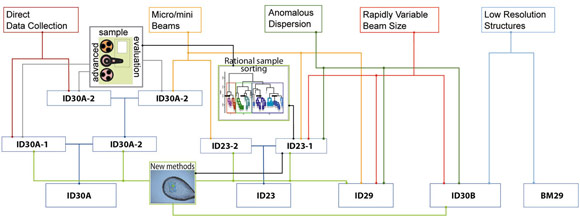- Home
- Users & Science
- Scientific Documentation
- ESRF Highlights
- ESRF Highlights 2011
- Structural biology
Structural biology
The productivity of the ESRF’s Structural Biology facilities is currently unmatched within Europe. The basis of our success is the provision of many of the complementary techniques required to study complex problems. In this context, the ESRF Structural Biology Group provides tools, and crucially, access mechanisms, for experiments combining X-ray crystallography and bioSAXS (this may also be extended to bioSANS where appropriate); for experiments combining X-ray crystallography and spectroscopy; for experiments requiring the routine use of micro-focus X-ray beams in an automated fashion; for the collection of high quality diffraction data at both very high and very low resolutions. The provision of robust & reliable facilities for the experiments described above is coupled with the development of innovative methods. Most of the developments currently deployed result from the high quality in-house research carried out in the Group, examples of which are included in this chapter.
A brief perusal of the highlights selected here makes it clear that we continue to facilitate extremely high-quality research over a broad range of topics of fundamental biological interest. As usual, the space available means that we limit ourselves to highlighting some general themes and have not been able to include a very large number of deserving cases. That approximately 30% of the articles presented in the chapter concern the crystal structures of membrane proteins illustrates the growing importance of this research area throughout Europe. Until recently, the elucidation of a membrane protein structure was a notable event in its own right. Today, however, we see sophisticated sets of experiments that provide an understanding, at an atomic level, of how these crucial cellular components function.
Despite the excellent Science summarised in this chapter, the years 2011 and 2012 may be most remembered for the construction work required for an upgraded ESRF which will ultimately provide many new opportunities for more advanced research. During this period the Structural Biology Group will do its utmost to maintain the quality of the service we provide while, at the same time, we manage the decommissioning of the ID14 complex of beamlines and the construction and commissioning of its replacement on ID30. The latter is well under way with key goals and targets met.
While the construction of a new set of beamlines will lead to a number of short-term inconveniences for our User Community - not least of which will be a loss of beamtime capacity - we are confident that the upgraded facilities will provide the tools necessary for a radical change in the way structural biology research is supported at the ESRF. The practice of sample screening will be greatly enhanced and simplified, it will be possible to investigate samples in a completely automated fashion with precise control over the nature of the screening carried out and the development of optimal diffraction experiment plans. Where appropriate, enhanced automatic data collection and treatment will be available. Access to microfocus beams will be extended both in capacity and smallest beam size available. This process has already been started through the tuneable aperture sizes available on ID29 and ID23-1. Greatly improved automation will also be made available through a combination of new hardware and software, data tracking and selection of the most appropriate sub-sets of data – leading to the possibility to collect highest resolution, most isomorphous, data sets from multiple crystals. The quality of the operation of the facilities at long wavelength and the flexibility of beam (size) provision will also be improved. Finally, by the end of the construction of ID30, users will be able to collect very low resolution diffraction data with microbeams of a very low divergence. Thus, we expect to deliver a suite of coordinated, multidisciplinary beamlines for researchers (see Figure 96) that will enable a paradigm shift in the way that Structural Biology problems are approached.
 |
|
Fig. 96: The suite of coordinated, multidisciplinary beamlines for Structural Biology research that will result from Phase I of the ESRF Upgrade. |
We hope you will bear with us until the upgrade of our facilities has been successfully completed.
S. McSweeney and G. Leonard



